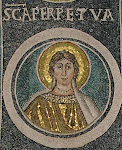
I think the painting Rachel saw was a genre painting of Cornelia. This subject was very popular in the 18th and 19th century. Cornelia was a Roman noblewoman born almost 200 years before Christ. She was widowed and refused to remarry, devoting herself to raising her children. Cornelia is the origin of the "These are my jewels," quotation. I like theEncarta write-up on Cornelia, but I took this image from the Wikipedia article.
The idea of Cornelia and the rich woman has maintained its power over time, I think because our minds really do associate jewels with children. In Anglo-Saxon England, around 736 AD, Bede reports that the mother of the Abbess Hilda had a dream when she was pregnant that she pulled a most precious jewel from under her dress. This dream was understood to foretell the importance of the child in her womb. The metaphor of jewels for children even shows up in Freud's dream analysis. In Dora's first dream, she wants to save her jewelry box from a fire and Freud makes the association of the jewelry box with the woman's womb.





No comments:
Post a Comment